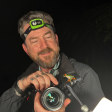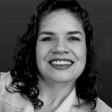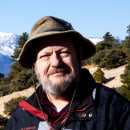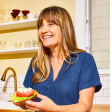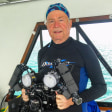Food Photography Speakers
You've already got the theme, the venue, and the audience.
Now you're stuck on one thing: who's going to speak about food photography in a way that actually connects?
You're not just looking for someone who knows how to shoot a plate of pasta.
You want someone who can talk about the craft, the culture, and maybe even the chaos behind the lens.
But how do you find the right food photography speakers for your event or show?
That's where it usually gets tricky.
Not every great photographer is a great speaker.
And not every speaker understands the visual language of food.
This list makes it easier.
We've pulled together standout food photography speakers who know how to bring real value on stage or behind the mic.
From styling tips to storytelling through imagery, these folks know their stuff and know how to deliver it.
I've seen how the right voice can shift the energy in a room or bring a podcast segment to life.
Explore the food photography speakers featured here and book someone who truly fits your audience.
Top Food Photography Speakers List for 2025
Mikyla Meckelson
Food Photographers with a sense of humor and tips to run a creative business you love
Rob Knight
Creative photographer, traveller, and photo educator
Andrea Denney
Fine Art Photographer · 2x Author . Transformative Speaker · Podcaster • Keeper of Memory Through Stillness & Image
John Mollura
Stop procrastinating, take control, build your legacy.
Dana Garrett
From Chief Petty Officer to Visual Storyteller: Embracing Life's Journeys
Catherine Smart
To help ADHDers and people with busy brains build confidence and tap into their creativity, starting in the kitchen.
Dominique Hart
Empowering brands to thrive through dynamic design and strategy.
Robert Herb
Professional Underwater Photographer working as the Photo Pro at a major resort in Roatan, Honduras.
What Makes a Great Food Photography Speaker
Take someone like Joanie Simon or Andrew Scrivani. When they speak, they don't just explain how to shoot a burger. They walk you through the creative process - the failed attempts, the lighting hacks, the cultural influences behind a dish. A great food photography speaker brings the audience into their world, whether they're talking to culinary students in Paris or tech entrepreneurs in San Francisco who want to up their Instagram game.
But it's not just about storytelling. Delivery matters. The best speakers know how to pace their talk, use visuals effectively, and engage with the audience. They might ask questions, show behind-the-scenes footage, or even do a live demo. They're not afraid to get messy or show imperfections, because that's where the real learning happens.
And here's the kicker: they're generous. They share tips, tools, and resources without holding back. Whether it's their Lightroom presets or their go-to tripod, they give the audience something tangible to walk away with.
So if you're scouting for a great food photography speaker, look for someone who blends passion, precision, and personality. Someone who makes food feel alive through the lens - and makes you want to grab your camera and try it yourself.
How to Select the Best Food Photography Speaker for Your Show
1. Define Your Audience and Objectives.
- Are you hosting a summit for professional photographers, food bloggers, or restaurant owners? Each group will expect different insights.
- Decide whether you want a speaker who can teach technical skills, inspire creativity, or share business strategies.
2. Search Smart Using Platforms Like Talks.co.
- Use Talks.co to browse speaker profiles, watch sample talks, and read reviews from other hosts.
- Filter by niche, experience level, and availability. Look for speakers who've presented at similar events.
3. Review Their Speaker Page Thoroughly.
- A strong speaker page should include a bio, past speaking engagements, sample videos, and clear topic titles.
- Look for testimonials from past hosts or attendees. Bonus points if they've spoken at international events or cross-industry summits.
4. Assess Presentation Style and Fit.
- Watch at least one full-length talk. Are they engaging? Do they explain complex ideas clearly?
- Consider whether their tone matches your event's vibe - casual, academic, high-energy, etc.
5. Reach Out and Ask the Right Questions.
- Ask how they tailor talks for different audiences. Get a sense of how flexible and collaborative they are.
- If possible, schedule a quick call to gauge chemistry and communication.
Remember, the best food photography speaker for your show isn't always the most famous - it's the one who can connect with your audience and deliver real value in your format.
How to Book a Food Photography Speaker
1. Shortlist Your Top Picks.
- After browsing platforms like Talks.co or reviewing speaker directories, narrow down your list to 2-3 candidates.
- Make sure they're available for your event date and time zone.
2. Reach Out with a Clear Pitch.
- When you contact them (via email or Talks.co messaging), include key details: event name, audience type, format (live, virtual, hybrid), date, and expected compensation.
- Be specific about what you're looking for: keynote, panelist, workshop leader, etc.
3. Discuss Customization and Deliverables.
- Ask if they can tailor their talk to your audience. For example, a session for food influencers might focus on smartphone photography, while a culinary school might want DSLR techniques.
- Clarify what you'll need from them: headshot, bio, slides, tech requirements.
4. Confirm Logistics and Sign an Agreement.
- Use a simple speaker agreement to outline expectations, payment terms, cancellation policy, and usage rights (especially if you're recording the session).
- Confirm the tech setup, rehearsal dates (if any), and promotional timelines.
5. Promote and Prep.
- Feature your speaker on your event page and social media. Use their name and topic to drive interest.
- Schedule a pre-event call to go over flow, timing, and audience interaction.
Booking a food photography speaker is part logistics, part relationship-building. Treat them like a partner, not just a guest, and you'll get a much better result.
Common Questions on Food Photography Speakers
What is a food photography speaker
At its core, food photography is a multidisciplinary field. It blends visual storytelling, culinary knowledge, lighting science, and often digital marketing. A food photography speaker might be a professional photographer, a food stylist, a content creator, or even a chef who's mastered the visual side of their craft.
They typically speak at industry events, online summits, webinars, culinary schools, or marketing conferences. Their sessions can range from hands-on lighting demos to talks about building a personal brand on Instagram or licensing images for commercial use.
Unlike general photography speakers, food photography speakers focus on the nuances of food as a subject. Think about how steam is captured, how sauces are styled, or how cultural context influences plating. These aren't just aesthetic choices - they're strategic decisions that impact how food is perceived and sold.
So whether they're speaking to restaurant owners in Tokyo or food bloggers in Toronto, these experts help audiences understand how to make food look as good as it tastes - and how to turn that skill into a career or business advantage.
Why is a food photography speaker important
Food photography is no longer just a niche skill. It's a business driver. From e-commerce platforms selling gourmet ingredients to meal delivery startups in Nairobi, compelling food imagery is what converts browsers into buyers. A food photography speaker helps businesses and creatives understand how to leverage visuals for engagement, branding, and revenue.
In educational settings, these speakers bridge the gap between culinary arts and visual communication. Culinary students in Paris or hospitality entrepreneurs in Mumbai benefit from learning how to present food in a way that resonates with modern audiences - especially on social media.
They're also crucial in demystifying the technical side of food photography. Lighting, composition, editing, and even prop styling - these aren't intuitive for everyone. A skilled speaker breaks it down in a way that's accessible and actionable.
And finally, they bring credibility and inspiration. Whether it's a keynote at a food tech summit or a workshop at a local coworking space, a food photography speaker can elevate the conversation from 'how to take a nice photo' to 'how to build a visual brand that sells'.
What do food photography speakers do
- Teach Technical Skills. They explain how to use natural and artificial light, choose the right lenses, and master camera settings. For example, they might show how to shoot a flat lay with a 50mm lens or how to use a bounce card to soften shadows.
- Demonstrate Styling Techniques. From arranging props to selecting backdrops, they teach how to make food look fresh, appetizing, and authentic. This could include showing how to style a melting scoop of ice cream or how to plate a dish for a rustic vs. modern aesthetic.
- Share Business Insights. Many food photography speakers talk about pricing, licensing, working with brands, and building a portfolio. They might walk through real client briefs or explain how to pitch to food magazines.
- Inspire Creativity and Innovation. They often discuss trends like dark food photography, minimalism, or cultural storytelling. Some even explore how AI tools or mobile apps are changing the game.
- Engage with Diverse Audiences. Whether it's a virtual summit for food bloggers in Latin America or a live workshop for chefs in New York, they adapt their content to suit different skill levels and cultural contexts.
In short, food photography speakers don't just talk about taking pictures. They help people understand the 'why' behind the image, the 'how' of the process, and the 'what next' for turning those skills into impact or income.
How to become a food photography speaker
1. Build Your Food Photography Portfolio
- Before anyone will listen to you speak, they need to see what you can do. Create a strong portfolio that showcases your style, versatility, and skill. Include client work, personal projects, and behind-the-scenes shots.
- Tip: Use platforms like Instagram and Behance to get visibility. Tag your work with relevant hashtags and engage with the food photography community.
2. Define Your Niche and Message
- Are you an expert in natural lighting? Do you specialize in editorial food shoots or restaurant branding? Clarify what makes your work unique and what message you want to share.
- Example: Instead of just 'food photography', you might focus on 'storytelling through food imagery for indie food brands'.
3. Create a Speaker Page
- Set up a dedicated speaker page on your website. Include your bio, speaking topics, testimonials, high-res headshots, and a demo reel if possible.
- Mention past speaking engagements, even if they're webinars or Instagram Lives. If you're just starting out, host your own mini-event to get that first gig under your belt.
4. Join Platforms Like Talks.co
- Talks.co is a great place to connect with event hosts looking for speakers. Create a profile, list your topics, and make it easy for hosts to find and book you.
- Pro tip: Use keywords like 'food styling', 'visual storytelling', and 'brand photography' to increase your discoverability.
5. Pitch Yourself to Events and Podcasts
- Start with food industry events, photography workshops, and podcast interviews. Craft personalized pitches that highlight what value you bring to their audience.
- Example: 'I'd love to speak at your culinary marketing summit about how food photography can drive online sales for small food businesses.'
6. Collect Feedback and Refine
- After each talk, ask for feedback. What resonated? What could be clearer? Use this to improve your delivery and content.
- Bonus: Turn positive feedback into testimonials for your speaker page.
The more you speak, the more visible you become. And visibility leads to more opportunities. Keep refining your message and showing up where your audience is.
What do you need to be a food photography speaker
1. Expertise in Food Photography
You need to know your craft inside and out. This includes technical skills like lighting, composition, editing, and styling. But it also means understanding trends in food media, branding, and consumer behavior. Whether you're self-taught or formally trained, your work should reflect a deep understanding of the field.
2. A Clear Point of View
What makes your approach different? Maybe you focus on sustainable food systems, or maybe you're a master of moody lighting. Your unique perspective is what makes you valuable as a speaker. It helps you stand out and connect with specific audiences.
3. Communication Skills
You don't need to be a TED Talk veteran, but you do need to articulate your ideas clearly and confidently. Practice explaining your process, telling stories behind your shoots, and breaking down complex techniques for beginners.
4. A Speaker Platform
This includes a speaker page, a short bio, a list of topics you cover, and ideally a few clips of you speaking. Platforms like Talks.co make it easier to connect with event organizers and get discovered. They're especially helpful if you're just starting out.
5. A Network
Connections matter. Reach out to food bloggers, culinary schools, photography clubs, and marketing conferences. Many events are actively looking for speakers who can bring a fresh, visual perspective to their programming.
6. A Willingness to Teach and Inspire
Being a speaker is about giving. You're not just showing off your work, you're helping others learn and grow. That means being generous with your knowledge, open to questions, and adaptable to different audience levels.
In short, being a food photography speaker is about combining your creative skills with a passion for teaching. If you've got the knowledge and the drive, the stage is waiting.
Do food photography speakers get paid
Event Type Matters
- Corporate Conferences: These tend to pay the most. If you're speaking at a marketing summit or a hospitality expo, you could earn anywhere from $1,000 to $10,000 per talk.
- Workshops and Masterclasses: These are often more hands-on and may pay less per session but offer upsell opportunities like private coaching or product sales.
- Podcasts and Webinars: Many of these are unpaid, especially for beginners. But they offer exposure and can lead to paid gigs down the line.
Experience and Reputation
- New speakers might start with free or low-paid gigs to build credibility.
- Established names with a strong portfolio and media presence can command higher fees.
Geographic Differences
- In the U.S. and Western Europe, speaker fees are generally higher.
- In emerging markets, compensation may be lower, but opportunities for brand partnerships and audience growth are strong.
Other Forms of Compensation
- Travel and accommodation.
- Free access to the event or networking opportunities.
- Product or brand collaborations.
So yes, food photography speakers do get paid, but the path to consistent income often starts with strategic unpaid gigs that build your profile. As your visibility grows, so does your earning potential.
How do food photography speakers make money
1. Speaking Fees
This is the most obvious source. Event organizers pay speakers to share their knowledge at conferences, workshops, and panels. Fees can range from a few hundred to several thousand dollars depending on the speaker's reputation and the event's budget.
2. Workshops and Masterclasses
Many speakers host their own events, either in-person or online. These can be highly lucrative, especially if they include hands-on training. For example, a weekend food styling workshop in New York might charge $500 per attendee with 20 participants.
3. Sponsored Talks and Brand Partnerships
Brands in the food, camera, or lifestyle space often sponsor speakers to represent them at events. A food photography speaker might be paid to present on behalf of a camera company or a kitchenware brand.
4. Online Courses and Digital Products
Speakers often repurpose their content into online courses, eBooks, or presets. Platforms like Teachable or Gumroad make it easy to sell these products globally.
5. Consulting and Coaching
Some speakers offer one-on-one coaching or consulting for aspiring photographers, food bloggers, or restaurant owners. These sessions can be billed hourly or as packages.
6. Affiliate Marketing
By recommending gear, software, or services during talks or on their websites, speakers can earn commissions through affiliate links.
7. Talks.co and Other Booking Platforms
Platforms like Talks.co help speakers get discovered and booked by event organizers. They often streamline payments and increase visibility.
In short, food photography speakers diversify their income across multiple channels. The more they speak and share, the more opportunities they create to monetize their expertise.
How much do food photography speakers make
| Experience Level | Typical Fee per Talk | Annual Income Range (est.) |
|---|---|---|
| Beginner | $0 - $500 | $5,000 - $20,000 |
| Mid-Level | $500 - $2,000 | $20,000 - $75,000 |
| Established Expert | $2,000 - $10,000+ | $75,000 - $250,000+ |
- Event Type: High-profile conferences pay more than local meetups.
- Geography: Speakers in North America and Western Europe tend to earn more.
- Niche: Those who combine food photography with marketing, branding, or tech can command higher fees.
- Digital Products: Speakers who sell courses or presets can significantly boost their income.
Real-World Examples
- A speaker like Joanie Simon, who runs The Bite Shot, may earn from YouTube, courses, and speaking engagements combined.
- In contrast, a local photographer in Southeast Asia might focus on regional workshops and brand partnerships.
While some food photography speakers make speaking their full-time income, many use it as one part of a broader business model. The key is to combine visibility with monetizable assets.
How much do food photography speakers cost
1. Speaker Experience
- New or Local Speakers: $250 - $1,000 per talk. Great for community events, small business meetups, or niche webinars.
- Mid-Level Professionals: $1,000 - $3,000. These speakers have a solid portfolio and some speaking experience.
- High-Profile Experts: $3,000 - $10,000+. These are well-known names with media exposure, published work, or a large following.
2. Event Type and Format
- In-Person Conferences: Higher cost due to travel, prep time, and logistics.
- Virtual Events: Typically 30-50% less expensive.
- Workshops: May include additional fees for materials, setup, or hands-on instruction.
3. Duration and Scope
- A 30-minute keynote costs less than a full-day workshop.
- Custom content or brand-specific presentations may add to the fee.
4. Location and Travel
- International speakers may require travel, accommodation, and per diem.
- Local speakers can be more budget-friendly and easier to coordinate.
5. Booking Platform
- Using platforms like Talks.co can streamline the process and provide transparent pricing.
Sample Cost Scenarios
- A 1-hour virtual talk by a mid-level speaker: ~$1,200.
- A 2-day in-person workshop with a top-tier expert: ~$8,000 + expenses.
Ultimately, the cost reflects the speaker's value, not just their time. If they can inspire your audience and deliver actionable insights, it's often worth the investment.
Who are the best food photography speakers ever
Andrew Scrivani: A long-time contributor to The New York Times and author of 'That Photo Makes Me Hungry', Andrew blends storytelling with practical technique in his talks.
Bea Lubas: A Polish-born, UK-based photographer, Bea is celebrated for her minimalist, natural-light style. She's spoken at events like The Photography Show and teaches workshops across Europe.
David Loftus: Best known as Jamie Oliver's photographer, David has decades of experience and a charismatic stage presence. His talks often explore the intersection of food, culture, and visual storytelling.
Rachel Korinek: The Australian-born creator of Two Loves Studio, Rachel is a Lightroom expert and educator. Her online courses and speaking gigs focus on editing and composition.
Daniel Krieger: A food and restaurant photographer based in NYC, Daniel brings a journalistic edge to his talks, often discussing how to work with chefs and publications.
Linda Lomelino: Known for her moody, dessert-focused photography, Linda has inspired thousands through her blog 'Call Me Cupcake' and speaking appearances in Scandinavia.
Mowie Kay: A London-based photographer with a lush, editorial style, Mowie has spoken at design and food events across Europe.
Who are the best food photography speakers in the world
Bea Lubas (UK/Poland): A global ambassador for Canon and a frequent speaker at international photography events, Bea combines artistic vision with practical instruction.
Rachel Korinek (Australia/Canada): Rachel's online courses have reached students in over 100 countries. Her talks focus on editing workflows and building a photography business.
Andrew Scrivani (USA): A veteran in the industry, Andrew brings decades of experience and a cinematic approach to food photography. He's spoken at major conferences like PhotoPlus and SXSW.
David Loftus (UK): With a portfolio that includes over 100 cookbooks, David is a legend in the field. His talks often explore the emotional connection between food and imagery.
Kimberley Hasselbrink (USA): Author of 'Vibrant Food', Kimberley's work is known for its color and freshness. She's spoken at design and photography festivals across the U.S.
Meeta K. Wolff (Germany/India): A multicultural voice in the industry, Meeta runs the 'From Plate to Page' workshop series and has spoken across Europe and Asia.
Luisa Brimble (Australia): A photographer and community builder, Luisa is known for her collaborative approach and has spoken at creative conferences like The Design Conference in Brisbane.
Common myths about food photography speakers
Not true. While culinary expertise can add flavor to your presentation, many successful food photography speakers come from photography, marketing, or even journalism backgrounds. What matters more is your ability to communicate visual storytelling and technical know-how. For example, Joanie Simon, known for The Bite Shot, built her speaking career on her photography skills and teaching style, not a culinary degree.
Myth 2: Food photography is just about taking pretty pictures.
This one misses the point entirely. Food photography speakers often dive deep into lighting techniques, composition theory, color psychology, and even consumer behavior. Brands don't just want pretty-they want conversion. Speakers like Andrew Scrivani, who has worked with The New York Times, often discuss how visual choices impact engagement and sales.
Myth 3: Only big-city professionals get booked to speak.
Actually, many speakers come from smaller markets and leverage online platforms to build global audiences. Virtual summits, like those hosted on platforms such as Virtual Summit Software, have democratized access. A food photographer from a rural town in Canada can now speak to thousands worldwide without ever stepping on a plane.
Myth 4: You have to be a full-time speaker to be taken seriously.
Nope. Many food photography speakers balance client work, content creation, and speaking gigs. In fact, having an active portfolio keeps your insights fresh and relevant. It's not about being a full-time speaker-it's about delivering value when you do speak.
Myth 5: Speaking is only for extroverts.
Plenty of successful speakers are introverts who prepare deeply and deliver with clarity. The key is authenticity. If you're more analytical, lean into that. If you're more visual, use that strength. The speaking world has room for many voices-as long as they're clear, helpful, and real.
Case studies of successful food photography speakers
Then there's David Loftus. Known as Jamie Oliver's go-to photographer, David didn't just ride the wave of celebrity. He carved his own lane. His talks at photography expos and culinary schools are packed with behind-the-scenes stories and lighting breakdowns. He doesn't just show pretty images-he explains the why behind every shadow and highlight.
In Southeast Asia, Samantha Lee took a different route. Her whimsical food art, originally created to encourage her kids to eat, went viral. That virality turned into TEDx talks, brand collaborations, and educational workshops across Malaysia and Singapore. Her case proves that a unique visual voice can open doors to speaking, even without formal training.
And let's not forget about Rachel Korinek of Two Loves Studio. She built a reputation through online courses and Lightroom presets, then transitioned into speaking at virtual summits and photography conferences. Her technical depth and clear teaching style resonate with both beginners and pros. Her story shows that digital products can be a stepping stone to the stage.
Each of these speakers took a different path. Some started with blogs, others with brands. Some leaned into education, others into artistry. But they all share one thing: a clear message and the courage to share it.
Future trends for food photography speakers
One major trend: interactive speaking formats. Audiences are no longer satisfied with passive slide decks. They want live demos, real-time editing, and Q&A sessions that go beyond surface-level tips. Expect more speakers to integrate live Lightroom workflows or mobile photography breakdowns into their presentations.
Another shift is the rise of cross-disciplinary talks. Food photography is now intersecting with sustainability, AI, and even psychology. Speakers who can connect visual storytelling with ethical sourcing or consumer behavior are landing more diverse gigs-from food tech conferences to wellness expos.
Here are a few trends to watch:
- Micro-niche expertise. Speakers focusing on plant-based styling, cultural cuisine photography, or smartphone-only workflows are gaining traction.
- Virtual-first events. Even as in-person events return, virtual summits and hybrid conferences remain strong. Platforms like HeySummit and Airmeet are making it easier to deliver high-quality virtual talks.
- AI-enhanced workflows. Tools like Luminar Neo and Adobe Firefly are changing how photographers edit. Speakers who can teach or critique AI-assisted photography will be in demand.
- Global reach, local flavor. There's growing interest in regional food photography styles. Speakers from Latin America, Africa, and Southeast Asia are bringing fresh perspectives to global stages.
In short, the future belongs to those who can teach, adapt, and connect across disciplines. If you're thinking of stepping into this space, now's a great time to carve your niche.
Tools and resources for aspiring food photography speakers
Virtual Summit Software. If you're ready to host your own event or co-host with others, this platform makes it easy to manage speakers, sessions, and replays. Great for building authority fast.
Canva Presentations. Not just for social media graphics-Canva's presentation tools are sleek, easy to use, and perfect for creating visually stunning decks that showcase your food photography.
The Bite Shot YouTube Channel. Run by Joanie Simon, this channel is packed with tutorials on lighting, styling, and gear. Watch how she explains concepts-it's a masterclass in speaker pacing and clarity.
SpeakerHub. A directory where you can list your profile, find speaking opportunities, and connect with event organizers. Make sure to upload a reel that includes both your photography and your speaking clips.
Notion. Use it to organize your speaking topics, track pitch emails, and store slide decks. Create a 'Speaker HQ' dashboard to keep everything in one place.
Adobe Lightroom Classic. Still the go-to for editing food photos. If you're demoing techniques during a talk, know this tool inside out. Bonus: use Lightroom's before/after feature live to wow your audience.
Clubhouse. While not as hot as it once was, niche rooms on food photography still pop up. It's a low-pressure way to practice speaking and test topic ideas with a live audience.

